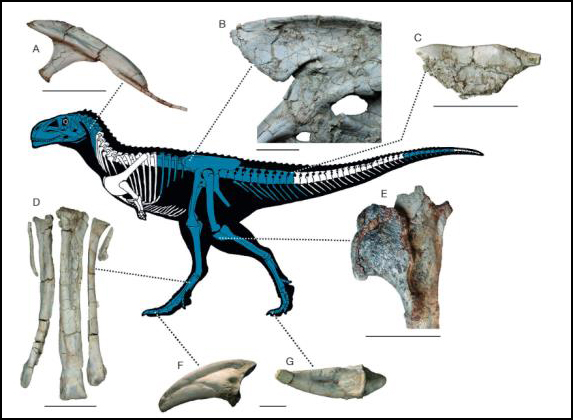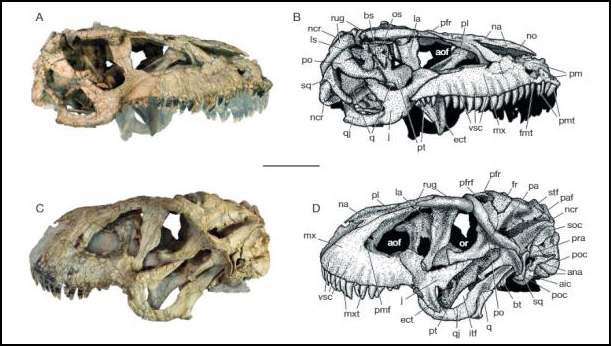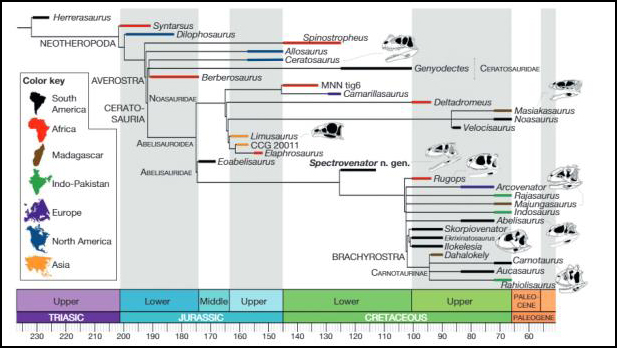A New Basal Abelisaurid is Described “Ghost Hunter”
A New Basal Abelisaurid – Spectrovenator ragei
Researchers from the Universidade de São Paulo (Brazil), in collaboration with colleagues from the Museo Paleontológico Egidio Feruglio (Argentina), have described a new species of basal abelisaurid from the Early Cretaceous of Brazil. The theropod has been named Spectrovenator ragei, the genus name translates from the Latin as “Ghost Hunter” as the fossilised remains were found unexpectedly underneath the holotype of the titanosaur Tapuiasaurus macedoi when the fossils of this dinosaur were being partially prepared by the field team.
An Illustration of Spectrovenator ragei with Key Fossils Highlighted that Help to Define the Dinosaur’s Taxonomy

Picture credit: Zaher et al
Spectrovenator ragei
The species or trivial name honours the late Dr Jean-Claude Rage, an eminent French researcher who made a significant contribution to the study of South American Mesozoic vertebrates.
Described from a partially articulated skeleton including a virtually complete skull, the dinosaur is thought to have measured around 2.2 metres in length and it is the first Early Cretaceous abelisaurid known with an almost complete skull. The cranial material has helped the researchers to demonstrate the evolution of abelisaurid skulls from the earliest, most basal Eoabelisaurus to the abelisaurids that existed in Gondwana during the later stages of the Cretaceous.
Views of the Skull with Accompanying Line Drawings

Picture credit: Zaher et al
A Dinosaur Skull to Study
With a beautifully preserved skull to study, the scientists have been able to compare the function of the skull and jaws of Spectrovenator with more derived members of the Abelisauridae. The Early Cretaceous Spectrovenator (Barremian-Aptian), lacks the specialisations, such as a high occipital region and highly flexible jaw joints linked to a modified feeding strategy suggested for much later abelisaurids. For example, some scientists, think that large-bodied abelisaurids such as Carnotaurus (C. sastrei) specialised in hunting titanosaurs (large prey).
The lack of these specialisations in the skull of Spectrovenator suggests this modified feeding strategy may be restricted to Late Cretaceous abelisaurids and linked to an increase in body size by this type of predatory dinosaur which occurred during the Cenomanian and through to the Maastrichtian.
Phylogenetic relationships of Spectrovenator within the Ceratosauria

Picture Credit: Zaher et al
Understanding the Abelisauridae
The discovery of Spectrovenator helps to fill a sizeable gap in the evolutionary history of the Abelisauridae. The earliest member of the Abelisauridae described to date Eoabelisaurus (E. mefi), is known from the Middle Jurassic of Argentina (around 166 million years ago), whilst other abelisaurids such as Rugops and Skorpiovenator are known from Upper Cretaceous sediments (100 million years ago approximately). Whereas Spectrovenator was found in strata that is approximately 120 million years old.
The scientific paper: “An Early Cretaceous theropod dinosaur from Brazil sheds light on the cranial evolution of the Abelisauridae” by Hussam Zaher, Diego Pol, Bruno Albert Navarro, Rafael Delcourt and Alberto Barbosa Carvalho published in Comptes Rendus Palevol.
The Everything Dinosaur website: Everything Dinosaur.

